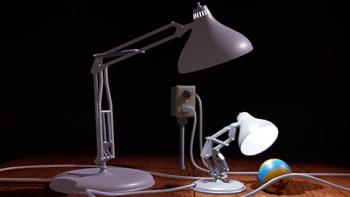The Fabulous Disney Babe
Page 1 of 3
A Tribute to John Lasseter, Part 2
Luxo Jr. was a huge hit. Expecting to hear kudos about the great technological jumps made with the software, John instead kept hearing: "What software? It was funny!" It dawned on him that computer animation was an art form grown out of a science; that characters could be "brought to life", not just made to look cool. He thought of all of the principles and theories developed at the knee of the elder animators at the Disney studio: if you apply those same principles to computer animation, you can make those characters come to life. (Watch Luxo Jr)

Luxo Jr. (c) Pixar
He also explained that the term CGI is a misnomer - the computer doesn't generate the images. That would be like calling traditional animation Pencil-Generated Imagery. No matter what the tool is, it requires an artist to create art. Computer animation, like other animation forms, is Person Generated.
He began encouraging others to use this tool. In computer animation's early days, the "camera" POV was flying everywhere, just because it could. There was little story and more than a bit of airsickness in the burgeoning industry. Luxo Jr. was different in this sense, but not for artistic reasons: whenever anyone else turned on their keyboard in the studio, the computer slowed to a crawl. There simply wasn't enough energy to create a flying wonder of a film in the time necessary. The simply couldn't afford the extra hardware and energy it would take, so they decided to have a plain, still black background and no "camera movement" to save money.
But because of this, people focused on the characters and not the "ooh" factor of computer animation and what it could do. Jim Lynn, a fellow computer animation geek, came running up to John after Luxo Jr. showed. "he's gonna ask about the shadow algorithm or something" thought John. No. "Was the parent like a mother or a father?" Jim wanted to know.
STORY WAS KING.
That moment gave John such inspiration; he knew he was on the right track. "I'm the luckiest person in the world" he said. "I have the best job in the world. I'm Pixar's ONLY animator!" Yes, Pixar, at the time of Luxo Jr., employed ONE animator: John Lasseter. The company's grown a little since then.
His friend had a baby. His sister had one, too. "Let's try something with a baby". He thought. He sat down and watched as his friend videotaped the baby; she put the baby on a blanket with some toys and let the camera roll. There was no camera movement, no "here's Grandpa", just the baby. John, who as an animator loved motion, was enthralled at what he saw.
Even in traditional animation, no one had really done a baby the way babies actually move and behave. How they grab things, how everything ends up in their mouths - "the poor toy", John thought, watching yet another toy be chewed and drooled on. THE POOR TOY!!!!!!!
To a little toy, a baby would probably be a horrific monster. Enter Tin Toy. The short was twice as long and twice as hard as anything they'd ever done. For the modeling and animation, the RenderMan was developed for this film. John and Ed started thinking about a feature-length computer animated film: "What kind of system will we need?" out of that grew RenderMan, which is now the Industry Standard. Ed won an Oscar(TM) for developing the technology. In the last ten years, there have been 26 films nominated for Special Effects, 24 of which used RenderMan. Almost any film with special effects uses it, and it was developed for Tin Toy.
